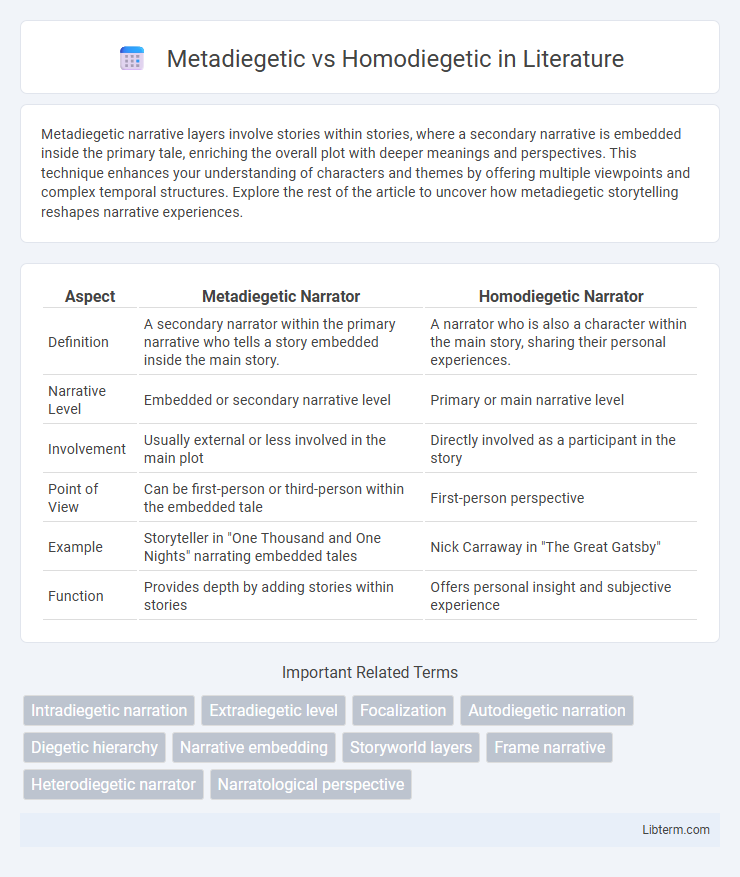Metadiegetic narrative layers involve stories within stories, where a secondary narrative is embedded inside the primary tale, enriching the overall plot with deeper meanings and perspectives. This technique enhances your understanding of characters and themes by offering multiple viewpoints and complex temporal structures. Explore the rest of the article to uncover how metadiegetic storytelling reshapes narrative experiences.
Table of Comparison
| Aspect | Metadiegetic Narrator | Homodiegetic Narrator |
|---|---|---|
| Definition | A secondary narrator within the primary narrative who tells a story embedded inside the main story. | A narrator who is also a character within the main story, sharing their personal experiences. |
| Narrative Level | Embedded or secondary narrative level | Primary or main narrative level |
| Involvement | Usually external or less involved in the main plot | Directly involved as a participant in the story |
| Point of View | Can be first-person or third-person within the embedded tale | First-person perspective |
| Example | Storyteller in "One Thousand and One Nights" narrating embedded tales | Nick Carraway in "The Great Gatsby" |
| Function | Provides depth by adding stories within stories | Offers personal insight and subjective experience |
Introduction to Narrative Voice
Metadiegetic and homodiegetic narrative voices define perspectives within storytelling layers, crucial in narrative theory. A homodiegetic narrator participates in the story world as a character, offering subjective insights, while a metadiegetic narrator exists inside a story within the story, providing nested narrative levels. Understanding these distinctions enhances analysis of narrative structure, focalization, and reliability in literary texts.
Defining Homodiegetic Narration
Homodiegetic narration occurs when the narrator is also a character within the story, providing a firsthand account of events from their personal perspective. This type of narration allows access to the narrator's inner thoughts, emotions, and motivations, creating a subjective and intimate storytelling experience. In contrast, metadiegetic narration involves a narrator embedded within a secondary narrative layer, often reflecting on or retelling events in a more detached or external manner.
Understanding Metadiegetic Narration
Metadiegetic narration involves a secondary narrative embedded within the primary story, where a character within the original narrative recounts another tale, creating a story-within-a-story structure. This technique allows for complex layering of perspectives and can reveal deeper thematic elements by contrasting different narrative levels. Understanding metadiegetic narration enhances comprehension of narrative dynamics and the function of nested storytelling in literature and film.
Key Differences Between Metadiegetic and Homodiegetic
Metadiegetic narration occurs within a secondary narrative embedded inside the primary story, often featuring a narrator who is a character within the original diegesis but not the focal character, while homodiegetic narration involves a narrator who is also a protagonist or participant in the main story world. Key differences include narratorial perspective, where homodiegetic narrators provide first-person accounts from within the story, whereas metadiegetic narrators tell stories nested within the main narrative, creating layers of storytelling. The distinction influences narrative reliability and focalization, with homodiegetic narrators offering subjective, experiential viewpoints, contrasting with metadiegetic narrators who position the audience within a framed narrative context.
Functions of Homodiegetic Narrators in Storytelling
Homodiegetic narrators actively participate in the story, providing firsthand perspectives that deepen character development and emotional engagement. Their subjective viewpoint enhances narrative reliability assessment and allows readers to experience events through an intimate lens. This function fosters a stronger connection between the audience and the narrative by embedding personal insights and biases directly into the storytelling process.
Role and Effects of Metadiegetic Narration
Metadiegetic narration occurs when a secondary narrative is embedded within the primary story, with a character from the main narrative recounting another tale, thereby creating multiple layers of storytelling that deepen the thematic complexity. This narrative mode intensifies the immersive experience by blurring boundaries between different narrative worlds, allowing for richer character development and expanded perspectives on the plot. The role of metadiegetic narration often involves offering insights, contrasting viewpoints, or revealing hidden motivations, which enhances the interpretive depth and emotional resonance of the overall narrative.
Famous Literary Examples of Homodiegetic Narrators
Famous literary examples of homodiegetic narrators include Holden Caulfield in J.D. Salinger's *The Catcher in the Rye*, who recounts his own experiences from a first-person perspective, creating a deeply personal narrative voice. Another notable example is Ishmael in Herman Melville's *Moby-Dick*, where the narrator participates in the story while describing events firsthand. These narrators contrast with metadiegetic narrators, who tell stories within stories without directly experiencing the events they narrate.
Notable Uses of Metadiegetic Narration in Literature
Metadiegetic narration appears prominently in works like Gerard Genette's theoretical explorations and complex narratives such as Italo Calvino's *If on a winter's night a traveler*, where stories exist within other stories, creating layers of embedded narratives. Notable examples include Edgar Allan Poe's "The Pit and the Pendulum," where a narrator recounts another character's tale, enhancing the atmospheric suspense through multiple narrative levels. This technique deepens reader engagement by disrupting linear storytelling and emphasizing the constructed nature of narratives.
Impact on Reader Perspective and Engagement
Metadiegetic narration, where a story is told within another story, often creates a layered reading experience that challenges the reader to distinguish between different narrative levels, enhancing cognitive engagement and interpretive depth. Homodiegetic narrators, being characters within the story they tell, foster intimacy and reliability, directly shaping the reader's perspective through personal bias and emotional involvement. The contrasting narrative distances affect how readers perceive authenticity and immersion, influencing emotional connection and interpretive complexity in literary works.
Conclusion: Choosing the Right Narrative Layer
Selecting the appropriate narrative layer depends on the desired level of intimacy and perspective within the story. Metadiegetic narrators convey embedded tales, enriching the narrative with multiple viewpoints and complex storytelling layers. Homodiegetic narrators, positioned as character-participants, deliver firsthand insights, fostering deeper emotional engagement and authenticity.
Metadiegetic Infographic

 libterm.com
libterm.com